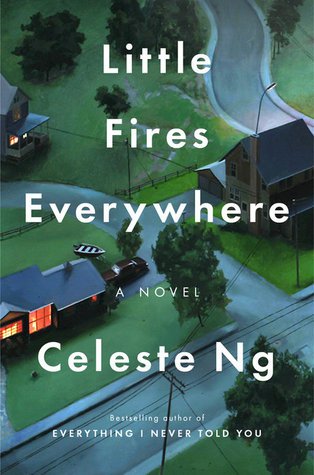 Title: Little Fires Everywhere
Title: Little Fires Everywhere
Author: Celeste Ng
Publication year: 2017
Rating: ★★½
Synopsis (via Goodreads): In Shaker Heights, a placid, progressive suburb of Cleveland, everything is planned—from the layout of the winding roads, to the colours of the houses, to the successful lives its residents will go on to lead. And no one embodies this spirit more than Elena Richardson, whose guiding principle is playing by the rules.
Enter Mia Warren—an enigmatic artist and single mother—who arrives in this idyllic bubble with her teenaged daughter Pearl, and rents a house from the Richardsons. Soon Mia and Pearl become more than tenants: all four Richardson children are drawn to the mother-daughter pair. But Mia carries with her a mysterious past and a disregard for the status quo that threatens to upend this carefully ordered community.
When old family friends of the Richardsons attempt to adopt a Chinese-American baby, a custody battle erupts that dramatically divides the town—and puts Mia and Elena on opposing sides. Suspicious of Mia and her motives, Elena is determined to uncover the secrets in Mia’s past. But her obsession will come at unexpected and devastating costs.
I will be honest: I went into Little Fires Everywhere with high expectations. In 2015, I read Celeste Ng’s stunning debut novel, Everything I Never Told You, and rated it as one of my top five reads of the year. When I heard that she had released a new book—and that just about everyone was raving about it—I was ecstatic, and vowed to get my hands on the text as soon as I could. I was so confident that I would love it that I selected it to be my first read of 2018. Which is why I sit here, so confused now, so disappointed, and still unsure as to what, exactly, did not work for me here.
Little Fires Everywhere follows the lives of two families in Shaker Heights: the Richardson clan, a family of four children led by uptight matriarch Mrs Richardson, and the Warrens, a working class mother-daughter pair who have just moved into the neighbourhood as tenants of the Richardsons. Teenage daughter Pearl Warren soon finds herself bound to the Richardson children after bonding with youngest brother Moody, and the novel spends quite a bit of time watching Pearl become more and more like family to the Richardson children, in a way taking the place of youngest child and outcast daughter Izzy, who is drawn to Pearl’s free-spirited mother Mia after she takes up work as the Richardsons’ new housekeeper.
However, the novel really starts moving when Linda and Mark McCullough, close family friends of the Richardsons, find themselves engaged in a custody battle over a Chinese-American baby, whose mother, Bebe Chow, initially abandoned her daughter at a fire station but has since cleaned up her act and desperately wants her child back. When Mrs Richardson and Mia find themselves on opposing sides of the argument, Mrs Richardson decides to dig into Mia’s past and uncover who, exactly, this mysterious artist is.
As with Ng’s predecessor, Little Fires Everywhere begins at the end—namely, with the burning down of the Richardson house at the hands of Izzy—before cycling back to explain how these characters arrived at such a point. The book starts off quite slow, taking its time to cement the relationships between the younger characters and follow them as they get up to their adolescent hijinks. While fun to read, the adventures of the teenage characters don’t feel totally necessary to the plot, and could have been cut out altogether. In fact, the pacing is all over the place in this book. Celeste Ng’s writing is compulsively readable, but more than a few times, I felt that scenes and storylines could have been cut or at least trimmed. This is especially true of the awkwardly positioned flashback scenes, which are so tedious, slow and involved that they kill any narrative tension that might have been built up beforehand.
And in fact, this flimsy narrative tension might be my central issue with Little Fires Everywhere. In Everything I Never Told You, Ng derives tension from her characters’ backstories; even though you already know how the book ends, the real question is how the characters get there. Although Little Fires Everywhere is similarly building to answer the “how did we get here?” question, it has the additional task of grappling with both the mystery of Mia Warren and the adoption plot, which run through most of the book. Who is Mia Warren? Who are her parents? How did she end up in Shaker Heights? And who will get to keep the Chinese-American baby? Should the struggling, biological mother with all her ties to Chinese culture get a second chance to raise her baby, or would the affluent adoptive parents, who have tried so hard and for so long to get a child and have been with the baby for most of its life, provide a better upbringing in the long term? Unfortunately, the novel takes a long time to really delve into either of these plots, and in the end, I felt that the custody battle was particularly poorly handled. It stands in the text as nothing more than a tool, an excuse to peek deeper into Mia’s life, and isn’t given any life beyond questions raised in the court room. Perhaps this would have worked better if we had looked deeper into the backstories of the McCulloughs and Bebe Chow instead of Mrs Richardson’s, a character who (except for providing a weak “order versus liberty” clash with Mia) feels very removed from the thematic conflicts. As much as I loved Mrs Richardson in this book, considering her to be its strongest character, her presence in the story (much like that of her kids) never truly sat right.
The question of what makes a mother a mother runs at the core of Little Fires Everywhere, and it, too, I thought to be poorly handled. Although the custody battle is handled with sensitivity and care, it isn’t given enough time on the page to be deeply explored. Instead, Mia’s backstory is supposed to delve deeply into this question, but it is deeply frustrating in its conclusion. Mia empathises with Bebe’s fight to keep her biological baby, but while Bebe has a genuine desire to keep her child, it feels as though Mia is more like the “baby stealer” that the McCulloughs are painted as by their opponents, driven more by guilt instead of a conscious, personal decision that she is doing the right thing. Let me be clear: I don’t care if what Mia does is right. I care if she believes it is right, a conclusion to which the narrative does not lead me, cheapening the emotional resonance of scenes with both Bebe and her daughter Pearl.
On the whole, I remained emotionally detached throughout this reading experience. In my opinion, Celeste Ng didn’t know what she wanted to communicate with this book, tried to cram too much in and ended with an underwhelming, overstuffed mess of a book. Had Little Fires Everywhere focused less on the Richardsons and more on the McCulloughs and Bebe Chow, I may have been more impressed. But ultimately, this was a disappointing read, and an unfortunate start to the new year.
Share this:





